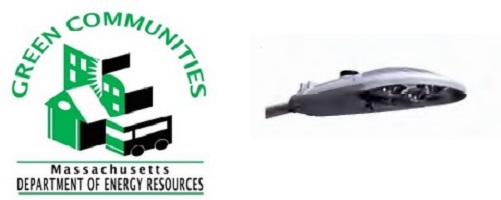Above: The Town is touting its energy savings through Green Communities. They’re also partnering with National Grid to try to reduce the energy costs for lighting streets. (image right cropped from January 3rd Select Board packet)
Carl Guyer shared an update with me on Southborough’s accomplishments in 2022 as a members of Massachusetts’ Green Communities program. It’s prompting me to also share news on the Town’s efforts to work with National Grid to save the town money (and reduce our energy footprint) by replacing streetlight bulbs with LEDs. The 2022 wrap-up announcement shares highlights on the grants received, work accomplished and the resulting savings, both this year and annually through the cumulative impacts:
2022 Green Communities Projects As as member of the Green Communities Program run by the Massachusetts Department of Energy Resources (DOER), Southborough has again in 2022 received funding from the DOER to reduce fossil fuel consumption by the town. The Green Community Designation and Grant Program provides a road map along with financial and technical support to municipalities that:
- Pledge to cut municipal energy use by an ambitious and achievable goal of 20 percent over 5 years and
- Meet four other criteria established in the Green Communities Act.
This year the Town of Southborough received funding in the amount of $100,000.00 from the 2022 Green Communities Competitive Grant Program. To qualify for funding, the town, along with the other designated Green Communities, submits a list of proposed projects to the DOER each year. Those projects considered best meeting the goals of the Green Communities Program are funded. For each year Southborough has participated, the town has been awarded the maximum allowable grant amount for its projects.
This years funds were used to finance an LED lighting conversion project, a boiler controls upgrades project, and assist in the purchase of one hybrid police cruiser. The LED lighting conversion project and boiler controls upgrades project were at Southborough’s P. Brent Trottier School. The anticipated annual fuel cost saving for this year’s project is $16,646.
For the 5 plus years Southborough has been a participant in this program, the town has received over $1,100,000 in grant funding. The energy efficiency upgrades made with this funding is anticipated to save the town over $110,000 every year in operational costs and are making a significant impact on the Green House gas emissions by the town facilities.
In the Select Board’s first meeting of the new year, Facilities Director John Parent noted that one of the first things that most Green Communities tackle is converting streetlights to LEDs. That’s something that Parent held off on pursuing since the Planning Board teamed up with an interested resident to try to reduce light pollution. (You can read more about the Dark Skies initiative and Planning’s successfully passed Lighting Bylaw here.)
Years ago, Parent asked his contact at National Grid, Bob Moran, if there was a dark skies friendly option. He was looking for something “3000 Kelvin” in keeping with the bylaw. At the time, the only LED option that National Grid could offer were 4000 KHz, which Parent described as bluer and brighter than most people like (and inconsistent with the bylaw). It took National Grid years to make the change, but they have now added 3000 Kelvin options. And according to Parent, they’re being snapped up by other communities.
Parent described the newer lights as more yellow and with a “nice, crisp cutoff”, reducing light pollution. The Town now has the ability to select from a list of lights for different spots in town. Once identified, they would be added to the list for National Grid to replace at no charge. Moran anticipated the work taking up to about a year.
Initially, the plan was to assume the current wattage on light poles is appropriate, and replace them with bulbs Parent believed were the closest equivalent based on outside advice he received.
Planning member Marnie Hoolahan and resident Destin Heilman who worked together on the Lighting bylaw joined the discussion with Parent, Moran and the Select Board.
From an environmental and fiscal perspective, everyone was supportive of making the conversions. But there was some debate and uncertainty about how bright the lights should/shouldn’t be in various locations. The Board wanted lights that illuminate enough for safety but agreed they shouldn’t be overly bright, especially in neighborhoods where they might disturb residents in their homes.
Heilman acknowledged that he is especially sensitive, but said that even the 3000 Kelvin lights are bluer than residents will be used to. He warned that as people age their eyes become more sensitive to road glare from blue lights. When it comes to driving, he argued that brighter isn’t always safer.
In the end, it was agreed that Moran would be provided 5-6 spots for him to install 15 Watt and 19 Watt LEDs so the Board could be better informed. (One example they discussed as a good place to compare was Flagg Road.) Parent was also asked to find out if police have concerns that there are any intersections that are currently too dimly lit.
Moran warned the Select Board that they are likely to hear from some residents after the change, and people can get emotional about lighting. He advised that whatever decisions they make, they should try to be consistent.
When the conversion work is done, the Town should receive an incentive payment of $61,000 for making the conversion, plus save $5,000 per month. (The cost differential could be greater in the future when the Town’s electricity rate changes, and even larger if they end up choosing more of the 15 W bulbs than initially planned.)


